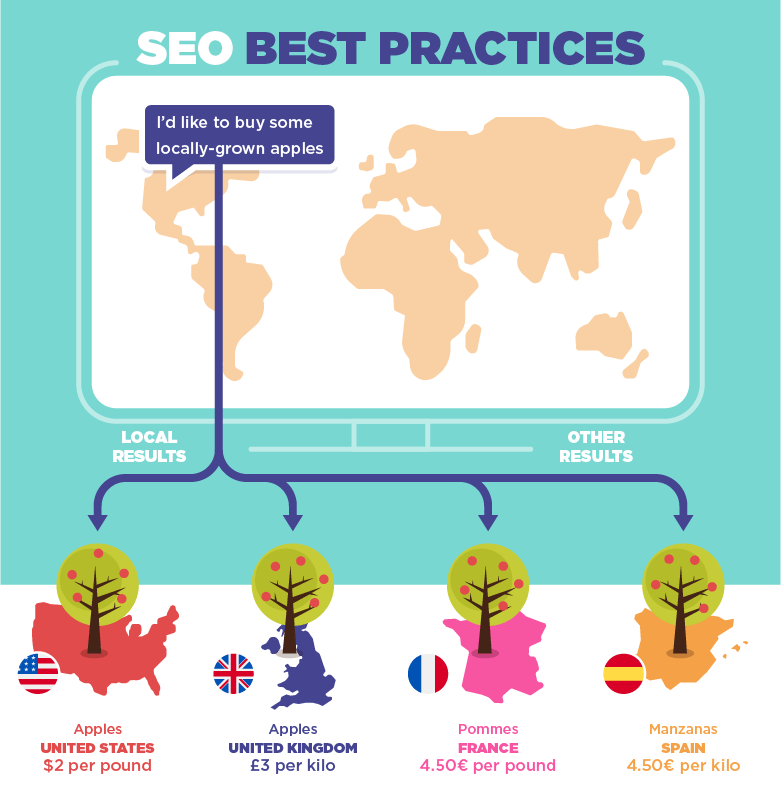


インターナショナルSEOとは、実践、より正確にはプロセスです。これは、ウェブサイトを最適化し、国際市場への展開を容易にすることを意味します。この最適化により、ターゲットとする国や、ウェブサイトに追加すべき言語を迅速に特定できるようになります。
自国だけでなく、世界各地から多くのアクセスをいただいていますか?もしそうなら、ウェブサイトをカスタマイズして、訪問者のエクスペリエンスを向上させることを検討してみてはいかがでしょうか。言語カスタマイズとは、世界中のユーザーに合わせてコピーを少し変更するだけでなく、場合によっては他の言語に翻訳することも含まれます。
インターナショナルSEOとは、より大規模なジオターゲティングです。つまり、SEOをローカル市場の潜在顧客獲得に重点を置くのではなく、様々な国や言語に合わせて調整するということです。
徹底的な国際 SEO 戦略には、いくつかのものが必要です。
国際化戦略は、まず特定のURL構造を採用することから始まります。国別トップレベルドメイン(ccTLD)、サブドメイン、サブフォルダ、言語パラメータ付きのgTLD、あるいは国ごとにカスタマイズされたドメインなど、様々な選択肢があります。
ccTLD
テクノペディア 国別コードトップレベルドメイン(ccTLD)は、「特定の国または地理的領域のドメインを定義するために使用されるトップレベルドメイン名」と定義されています。これらは通常、英国の場合は.uk、カナダの場合は.caのように2文字のコードです。
サブドメイン
ドメインの細分化であり、ベースドメインとのリンクエクイティを必ずしも持たない別の「第 3 レベル ドメイン」に配置されます。
サブフォルダ
ここで、2 文字の国コードはルート ドメインのサブフォルダーにあり、スラッシュ (/) で区切られています。
言語パラメータ付きgTLD
ルート ドメイン (.com、.net、または .org で終わる) が URL パラメータを通じて特定の言語を話すユーザーをターゲットにしている場合。
異なるドメイン
異なるドメインを持つということは、対象の国または言語を指定する新しいルート ドメインを作成するだけです。
検索エンジンはそれぞれ異なる方法で考慮するため、それぞれの選択肢をよく検討する必要があります。以下に、それぞれの選択肢がどのような意味を持つのかを少しご紹介します。
ここでは、さまざまな URL 構造の組み合わせで Web サイトを国際化できる方法と、それぞれの URL 構造が検索エンジンでどのように認識されるかを確認できます。
いずれにしても、検索エンジンでは、クローラーにとって使いやすいように、サイトの各セクションを同じような方法で整理することを推奨しています。
言語ターゲットをウェブサイト全体または特定のページのみに設定
hreflangまたは言語メタタグを使用することで、Googleなどの検索エンジンに、どの言語でコンテンツを追加するかを知らせることができます。以下の例では、このコンテンツがスペイン語でも利用可能であることを検索エンジンに伝えています。
<link rel="alternate" href="http://yourwebsite.com/es" hreflang="es-es"/>
その他のスマートな国際SEO対策
自動翻訳ではニュアンスが足りない理由は、コピーを翻案するということは、単に言葉を翻訳する以上の意味を持つからです。翻訳されたコンテンツを投稿する際は、元の投稿で意図した通りの文章にする必要があります。これは慣用句にとどまらず、ライティングに対する文化的なアプローチにまで及びます。
ターゲット地域の言語を使用するだけでなく、コンテンツをその地域のタイムゾーン、文化、通貨、さらにはユーモアのセンスに合わせて「変換」する必要があります。優秀な翻訳者やバイリンガルのコンテンツライターは、国際的なSEOにおいて不可欠な存在です。彼らはコンテンツをシームレスに別の言語へと変換することができます。最終的に、適切に翻訳されたテキストは、Googleがあなたのサイトを適切なユーザーに表示するのに役立ちます。
特定の国をターゲットにすることをお考えですか?ccTLDが最適な選択肢かもしれません。言語ターゲティングには、hreflang、サブフォルダ、サブドメイン(ccTLDの有無は問いません)など、それ以上の要素が必要になります。
Bright Vessel は、お客様のブランドがどこでも最大限の可能性を発揮できるよう、国際的な SEO ソリューションを提供します。 お問い合わせ あなたのウェブサイトを国際舞台に展開することについて。

"*「必須項目」は必須項目です

"*「必須項目」は必須項目です

"*「必須項目」は必須項目です
返信を残す
あなたは ログイン コメントを投稿するには。